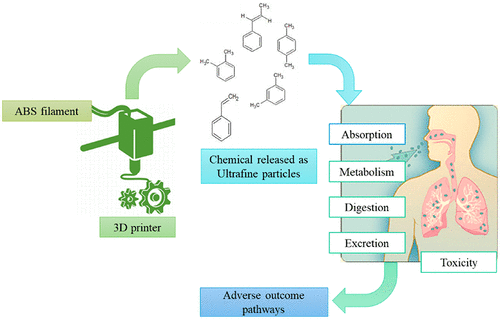当前位置:
X-MOL 学术
›
Chem. Res. Toxicol.
›
论文详情
Our official English website, www.x-mol.net, welcomes your feedback! (Note: you will need to create a separate account there.)
Integrated QSAR and Adverse Outcome Pathway Analysis of Chemicals Released on 3D Printing Using Acrylonitrile Butadiene Styrene
Chemical Research in Toxicology ( IF 4.1 ) Pub Date : 2021-01-08 , DOI: 10.1021/acs.chemrestox.0c00274 Shraddha Pandit 1, 2 , Prakrity Singh 1, 2 , Meetali Sinha 1, 2 , Ramakrishnan Parthasarathi 1, 2
Chemical Research in Toxicology ( IF 4.1 ) Pub Date : 2021-01-08 , DOI: 10.1021/acs.chemrestox.0c00274 Shraddha Pandit 1, 2 , Prakrity Singh 1, 2 , Meetali Sinha 1, 2 , Ramakrishnan Parthasarathi 1, 2
Affiliation

|
Additive manufacturing commonly known as 3D printing has numerous applications in several domains including material and biomedical technologies and has emerged as a tool of capabilities by providing fast, highly customized, and cost-effective solutions. However, the impact of the printing materials and chemicals present in the printing fumes has raised concerns about their adverse potential affecting humans and the environment. Thus, it is necessary to understand the properties of the chemicals emitted during additive manufacturing for developing safe and biocompatible fibers having controlled emission of fumes including its sustainable usage. Therefore, in this study, we have developed a computational predictive risk-assessment framework on the comprehensive list of chemicals released during 3D printing using the acrylonitrile butadiene styrene (ABS) filament. Our results showed that the chemicals present in the fumes of the ABS-based fiber used in additive manufacturing have the potential to lead to various toxicity end points such as inhalation toxicity, oral toxicity, carcinogenicity, hepatotoxicity, and teratogenicity. Moreover, because of their absorption, distribution in the body, metabolism, and excretion properties, most of the chemicals exhibited a high absorption level in the intestine and the potential to cross the blood-brain barrier. Furthermore, pathway analysis revealed that signaling like alpha-adrenergic receptor signaling, heterotrimeric G-protein signaling, and Alzheimer’s disease-amyloid secretase pathway are significantly overrepresented given the identified target proteins of these chemicals. These findings signify the adversities associated with 3D printing fumes and the necessity for the development of biodegradable and considerably safer fibers for 3D printing technology.
中文翻译:

使用丙烯腈丁二烯苯乙烯 3D 打印释放的化学物质的综合 QSAR 和不良结果通路分析
通常称为 3D 打印的增材制造在包括材料和生物医学技术在内的多个领域具有众多应用,并通过提供快速、高度定制和具有成本效益的解决方案而成为一种能力工具。然而,印刷烟雾中存在的印刷材料和化学品的影响引起了人们对其潜在影响人类和环境的担忧。因此,有必要了解增材制造过程中排放的化学物质的特性,以开发具有受控烟雾排放的安全和生物相容性纤维,包括其可持续使用。因此,在本研究中,我们针对使用丙烯腈丁二烯苯乙烯 (ABS) 长丝在 3D 打印过程中释放的化学品综合清单开发了计算预测风险评估框架。我们的结果表明,用于增材制造的 ABS 基纤维的烟雾中存在的化学物质有可能导致各种毒性终点,如吸入毒性、口服毒性、致癌性、肝毒性和致畸性。此外,由于它们的吸收、体内分布、代谢和排泄特性,大多数化学物质在肠道中表现出很高的吸收水平,并有可能穿过血脑屏障。此外,通路分析表明,α-肾上腺素能受体信号、异源三聚体 G 蛋白信号、考虑到这些化学物质的目标蛋白,阿尔茨海默病 - 淀粉样蛋白分泌酶途径的比例明显过高。这些发现表明了与 3D 打印烟雾相关的逆境,以及为 3D 打印技术开发可生物降解且相当安全的纤维的必要性。
更新日期:2021-02-15
中文翻译:

使用丙烯腈丁二烯苯乙烯 3D 打印释放的化学物质的综合 QSAR 和不良结果通路分析
通常称为 3D 打印的增材制造在包括材料和生物医学技术在内的多个领域具有众多应用,并通过提供快速、高度定制和具有成本效益的解决方案而成为一种能力工具。然而,印刷烟雾中存在的印刷材料和化学品的影响引起了人们对其潜在影响人类和环境的担忧。因此,有必要了解增材制造过程中排放的化学物质的特性,以开发具有受控烟雾排放的安全和生物相容性纤维,包括其可持续使用。因此,在本研究中,我们针对使用丙烯腈丁二烯苯乙烯 (ABS) 长丝在 3D 打印过程中释放的化学品综合清单开发了计算预测风险评估框架。我们的结果表明,用于增材制造的 ABS 基纤维的烟雾中存在的化学物质有可能导致各种毒性终点,如吸入毒性、口服毒性、致癌性、肝毒性和致畸性。此外,由于它们的吸收、体内分布、代谢和排泄特性,大多数化学物质在肠道中表现出很高的吸收水平,并有可能穿过血脑屏障。此外,通路分析表明,α-肾上腺素能受体信号、异源三聚体 G 蛋白信号、考虑到这些化学物质的目标蛋白,阿尔茨海默病 - 淀粉样蛋白分泌酶途径的比例明显过高。这些发现表明了与 3D 打印烟雾相关的逆境,以及为 3D 打印技术开发可生物降解且相当安全的纤维的必要性。


























 京公网安备 11010802027423号
京公网安备 11010802027423号